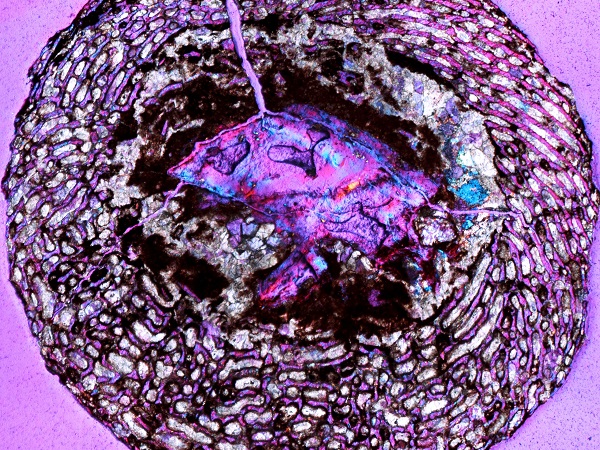Fossilized embryos shed light on dinosaur development

This image released by the University of Toronto shows a preserved femora, thigh bone, in cross section in middle of the shaft. The purple color is caused by the lamba filter used for effective visualization. The honeycomb like external area is embryonic bone tissue with large primary spaces for blood vessels, bone making cells called osteoblasts, and other soft tissues needed for growth. The central portion is the medullary cavity, but in this case filled with crystals that formed during fossilization. An international team of scientists discovered a cache of dinosaur embryos near the city of Lufeng, in Yunnan, China . Estimated to be 190 million years old, the fossilized bones are among the oldest dinosaur embryos in the world. AP/University of Toronto, A. LeBlanc
PARIS—Scientists on Wednesday said they had unearthed a treasure trove of fossilized dinosaur embryos dating back some 190 million years, a find that sheds light on how these enigmatic reptiles developed in the egg.
Palaeontologists excavated more than 200 bones from 20 embryonic dinosaurs in Lufeng in China’s Yunnan province, they wrote in the journal Nature.
The remains were from a long-necked herbivore called Lufengosaurus, a common dinosaur in the Early Jurassic period that measured about eight meters (26 feet) when fully grown.
Analysis of the femur, the longest bone in the dinosaur’s body, showed the reptiles grew very quickly inside the egg, which in turn suggests the Lufengosaurus had a short incubation period.
The team also found evidence that muscles played an active part in the developing femur by contracting and pulling on the hard bone.
“This suggest that dinosaurs, like modern birds, moved around inside their eggs,” said Robert Reisz of the University of Toronto Mississauga in Canada’s Ontario province.
“It presents the first evidence of such movement in a dinosaur.”